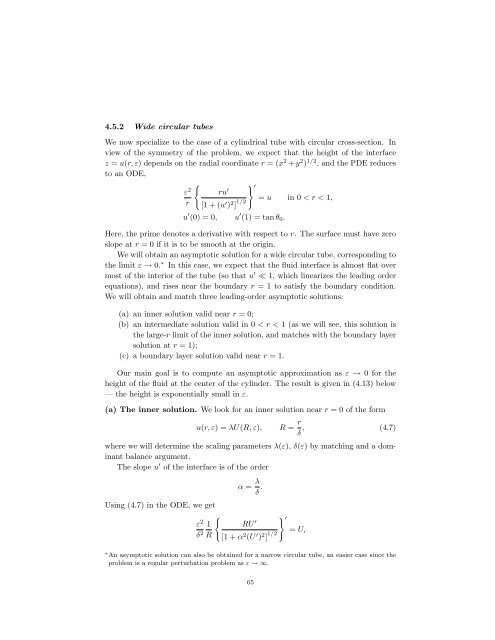Asymptotic Analysis and Singular Perturbation Theory
Asymptotic Analysis and Singular Perturbation Theory
Asymptotic Analysis and Singular Perturbation Theory
Create successful ePaper yourself
Turn your PDF publications into a flip-book with our unique Google optimized e-Paper software.
4.5.2 Wide circular tubes<br />
We now specialize to the case of a cylindrical tube with circular cross-section. In<br />
view of the symmetry of the problem, we expect that the height of the interface<br />
z = u(r, ε) depends on the radial coordinate r = (x 2 + y 2 ) 1/2 , <strong>and</strong> the PDE reduces<br />
to an ODE,<br />
ε 2<br />
r<br />
<br />
ru ′<br />
[1 + (u ′ ) 2 ] 1/2<br />
′<br />
u ′ (0) = 0, u ′ (1) = tan θ0.<br />
= u in 0 < r < 1,<br />
Here, the prime denotes a derivative with respect to r. The surface must have zero<br />
slope at r = 0 if it is to be smooth at the origin.<br />
We will obtain an asymptotic solution for a wide circular tube, corresponding to<br />
the limit ε → 0. ∗ In this case, we expect that the fluid interface is almost flat over<br />
most of the interior of the tube (so that u ′ ≪ 1, which linearizes the leading order<br />
equations), <strong>and</strong> rises near the boundary r = 1 to satisfy the boundary condition.<br />
We will obtain <strong>and</strong> match three leading-order asymptotic solutions:<br />
(a) an inner solution valid near r = 0;<br />
(b) an intermediate solution valid in 0 < r < 1 (as we will see, this solution is<br />
the large-r limit of the inner solution, <strong>and</strong> matches with the boundary layer<br />
solution at r = 1);<br />
(c) a boundary layer solution valid near r = 1.<br />
Our main goal is to compute an asymptotic approximation as ε → 0 for the<br />
height of the fluid at the center of the cylinder. The result is given in (4.13) below<br />
— the height is exponentially small in ε.<br />
(a) The inner solution. We look for an inner solution near r = 0 of the form<br />
u(r, ε) = λU(R, ε), R = r<br />
, (4.7)<br />
δ<br />
where we will determine the scaling parameters λ(ε), δ(ε) by matching <strong>and</strong> a dominant<br />
balance argument.<br />
The slope u ′ of the interface is of the order<br />
Using (4.7) in the ODE, we get<br />
<br />
ε2 δ2 1<br />
R<br />
α = λ<br />
δ .<br />
RU ′<br />
[1 + α 2 (U ′ ) 2 ] 1/2<br />
′<br />
= U,<br />
∗ An asymptotic solution can also be obtained for a narrow circular tube, an easier case since the<br />
problem is a regular perturbation problem as ε → ∞.<br />
65
















